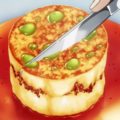Mostly for a Certain Group Only- Samurai Flamenco

I can usually formulate a set of feelings and judgment towards something, anime series included, as to whether something is a quality product or not and whether it is worth one’s time. Usually it is a question of how does it measure up to its counterparts and does it have any redeeming qualities surrounding it, versus the time commitment. But then again, how would one judge the series “Samurai Flamenco,” a series centered around the idiosyncratic Masayoshi Hazama?

Now, when I say “centered around,” it’s in a very sympathetic “bless his heart” way, as the multiple arcs that make up the entire series revolve Masayoshi’s development as the masked crusader “Samurai Flamenco.” Masayoshi starts off combating against such deplorable crimes as petty larceny and littering, and it is through his dialogues (or should I say lecturing) with the perpetrators does one begin to think whether this main protagonist truly has his priorities straight. This is especially true since most don’t take well to being reprimanded for jaywalking or taking out the trash too early and Masayoshi usually gets beaten up. At least secondary characters are introduced in a steady way as the story steadily progresses and Masayoshi’s backstory and double-life as a male model do lead to a certain amount of sympathy in contrast to his headdesk-worthy actions to make sure that society’s wrongs are righted.
Now, this premise could have made for an interesting-enough idiosyncratic slice-of-life story about one expressing and pursuing his own sense of justice, but instead the series gets cut up into several segments. As the show progresses, it also incorporates many elements of tokusatsu shows, as Masayoshi begins evolving from a costumed human being to fulfilling a childhood dream of being a superhero. However, it is here that things begin to take a turn for the strange, as a show originally portrayed as being entirely realistic has many elements of fantasy introduced, such as when Samurai Flamenco begins getting equipped with weapons… made out of office stationery. Now, introducing elements such as this I’m sure appeal to a certain crowd, but the majority of viewers probably saw this as bizarre enough to stop watching or begin losing interest. Introduce the “monster of the week” element and the series takes another bizarre turn for the strange as it continues its clumsy transition to a hybrid realism-fantasy. Eventually the show does settle into its new premise, but the partitioning of the series into smaller sub-blocks just comes off as forced and jarring. What the series seemed to try and do is to show Masayoshi’s progression as a hero, his trials and tribulations and how his dream came true… even if at times it felt more like a nightmare. But chopping and hacking up the plotline like this only made it feel like one is constantly getting uncomfortably shoved in the back just to make the plotline move.

New characters that get introduced throughout the series may be done steadily and at first come off as interesting but their idiosyncratic nature quickly wears thin and many characters’ idiosyncrasies become irritating. Perhaps the biggest offender is Mari Maya, a female member of an idol trio who join up temporarily with Masayoshi in the earliest arc to fight crime. While Mari’s method of punishment (sinking her heels to the offender’s crotch) may appeal to some, her descent after the middle-of-the-series “King Torture” arc clearly crosses the line into “uncomfortable and awkward” territory. The series’ portrayal at her attempts to regain relevance later on turns her (at least temporarily) into one of the most hated female characters in recent memory as she is engulfed by the green-eyed jealousy monster, though thank her friends for keeping her from ending on a sour note. In the later “Flamenger” arc, where the series further descends into the hybrid realism-fantasy arc, attempts to incorporate the story structure and multiple elements of mid-1990s series such as Power Rangers, Masked Rider, and VR Troopers, (vehicles combining into a larger robot, anyone?) introduces a quartet of cookie-cutter and heavily tropified color-coded characters to partner up with Masayoshi, now known as “Flamen Red.” Villains, if they are of the “weekly” variety are usually forgotten after the arc is over, but the main villains of each arc which last a few episodes do merit praise, especially the ones in the “Flamenger” arc and the final “Haiji” arc.
So what about the other aspects of the series? Well, it does seem to be made on a budget, but thankfully the animation and drawings don’t seem to scream them being overly cheap. The drawings get by, with some creativity in the character designs, but the shadowwork is in blocky gradients and the overly matte colors could do with a touch more vibrance and saturation, even with Masayoshi’s red outfit. The series oftentimes substitutes fight moves and choreographs with pictures of the moves instead, with a different background picture than the existing one to pump up the mood. Now, this is quite common in tokusatsu series, but the fact that it was done for cost purposes still somewhat shines through. Also noticeable is the lack of background music, though heavy kudos go to the catchy opening and ending themes which draw you in.

But here’s the thing: the music may draw you in, but the question is does this anime series have staying power? There seem to be many times where the series tries to be amusing, but the flavor of humor seems to be the type which would cause the casual fan to chuckle and then leave. Sure, my interest remained and “Samurai Flamenco” will more likely than not appeal to those who are tokusatsu fans, but that’s the problem with it. It backs itself into a corner in terms of likableness and offers its viewers a flavor of anime that appeals to a small pool of hardcore tokusatsu fans rather than a wide swath of viewers. Think wasabi-flavored ice cream levels of exotic. One can see what the anime tried to do but executionwise all of the elements just didn’t line up very well with one another. By all means give the series a try- tokusatsu fans will probably love it but for others, should you choose to drop it because it’s not your cup of tea, it’s perfectly understandable.





